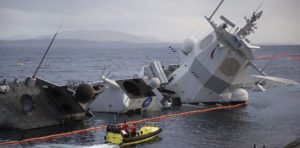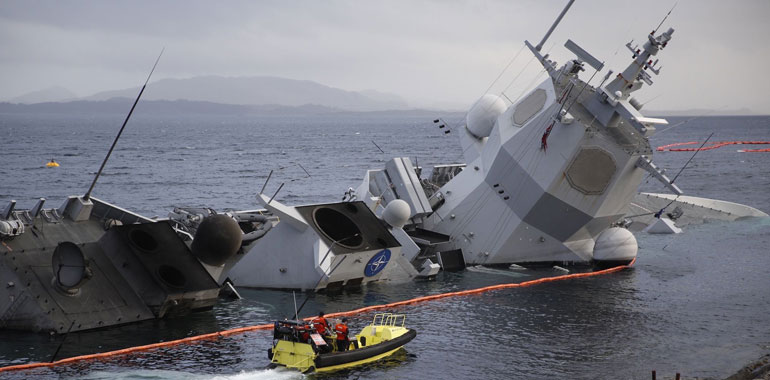
Despite time-tested collision avoidance regulations, sophisticated navigation systems and frequent amendments to STCW requirements, marine accidents continue to occur, with human error still the leading cause. “Safer Seas Digest,” a compendium of lessons learned from marine accident reports issued or adopted by the National Transportation Safety Board, shows some form of human error was the probable cause in 81 percent of 141 marine accidents investigated between 2013 and 2017. Marine accident reports from investigative agencies around the world reveal similar percentages.
People control every segment of the marine transportation industry, from regulatory and enforcement agencies, shipping companies, equipment manufacturers and vessel traffic services (VTS) all the way to a ship’s crew. Hence, human error originating in any of these entities may play a role in marine accidents. For this reason, a last line of defense against accidents must be established at the vessel.
In marine collisions, for example, regardless of where the chain of human error originates, the ultimate causation is almost always one or more violations of the navigation rules of the road. The collision involving the Norwegian frigate Helge Ingstad and tanker Sola TS on Nov. 8, 2018, is one of many examples. Although the bridge team on Helge Ingstad contacted the VTS operator prior to entering the Fedje traffic area in Norway, the operator did not adequately monitor vessels in the system. Moreover, radar, VHF radio and AIS were not appropriately utilized to assess the risk of collision. This incident, like almost every other collision, could have been prevented if the bridge team on either vessel had followed the navigation rules of the road.
A 2003 Nautical Institute survey on improving the application of COLREGS showed that almost 50 percent of deck watch officers believed that failure to follow the navigation rules of the road was caused by “ignorance” and/or “disregard” of these rules. The international survey also indicated that ignorance of COLREGS was “widespread” and not “confined by nationality or experience.” These findings are consistent with results from similar research conducted in the European Union and elsewhere around the world, and with the probable cause determined in many marine collision investigations.
Additionally, if some seafarers find these navigation rules difficult to understand and apply, what about the thousands of small boat operators who are only occasionally on the water? The U.S. Coast Guard’s annual “Recreational Boating Statistics” report showed that collisions with recreational vessels ranked No. 1 among primary marine accident types from 2009 to 2019.
Navigation rules of the road work if applied, but they’re not the easiest to understand. “Ignorance” of these rules almost goes hand in hand with “disregard.” After all, seafarers can’t appropriately apply what they don’t fully understand. All the legal verbiage in these rules can be confusing. And how about consistency? A power-driven vessel 50 meters or more in length is required to have two masthead lights, yet a trawler 50 meters or more in length is required to have only one masthead light. A power-driven vessel less than 50 meters in length is not required to have a second masthead light, but may opt to do so. Power-driven vessels are required to show sidelights and a sternlight when underway, even when not moving. Other vessels, such as fishing vessels, only need to show sidelights and a sternlight when making way through the water.
Learning these navigation rules of the road, without a doubt, is the only way to understand them. As a seasoned professional mariner and maritime educator for years, I have always been concerned about the difficulties many mariners face when trying to fully understand the rules. For example, Coast Guard merchant mariner credential (MMC) examination statistics from 2015 to 2018 show that 1,136 of 6,115 participants who took the navigation rules exam failed on the first attempt.
To improve these results, I began using multimedia to help learners prepare for their navigation rules of the road exam. This practice proved beneficial. An e-learning solution, especially in this pandemic era, is the most viable and cost-effective option to help learners better comprehend the rules. Also, since the Coast Guard stopped public disclosure of examination questions in accordance with the Coast Guard Authorization Act of 2015, understanding the rules is essential to passing the test.
Accordingly, I created “Navigation Rules of the Road Demystified” based on the science of successful learning, a student survey on navigation rules topics, and my teaching experience. The e-learning solution is threefold:
(1) Keep it super simple (KISS) — Use elaborations, references from nautical publications, illustrations and animations to simplify the rules.
(2) Keep learners engaged — Use practice questions with interactions such as “drag-and-drop” and swipe.
(3) Motivate learners to apply lessons learned — Use case studies from official marine accident investigation reports to reinforce navigation rules and serve as a somber reminder that accidents can happen anytime, anywhere and to anyone if measures to prevent them are ignored.
Shipping, like other high-risk transportation industries, requires a competent crew for safe operation. A bridge team’s understanding and application of the navigation rules of the road are paramount to prevent collisions and ensure the safety of the vessel and crew. Able-bodied seamen or other seafarers serving as part of a navigation watch should also understand the rules. After all, the more knowledgeable each member of a bridge team is, the safer the team. Further, these navigation rules apply to all vessels, meaning small boat operators should understand and adhere to them as well.
Navigation rules of the road competency is a win-win for all stakeholders. It will help prevent not only collisions, but allisions and groundings as well. An effective e-learning solution makes proficiency with these navigation rules possible for all mariners. •
Sam B. Pearson III is a professional mariner who holds an unlimited tonnage chief mate license and Nautical Institute unlimited dynamic-positioning operator certificate. He has experience sailing on many types of vessels, including tankers, LASH, containerships, underwater construction vessels, semi-submersible drilling vessels and oceangoing tugs. Pearson also has been a maritime educator and instructional designer for more than 20 years. He is currently an assistant professor at the California State University Maritime Academy.

